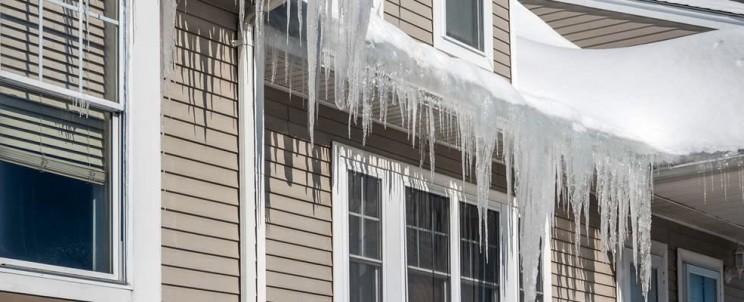Get an Immediate Response 24/7 - Water, Flood, Sewage, Mold - Insurance Claims Welcome 801-436-5225
Are Ice Dams Dangerous? 10 Things Everybody Should Know About Roof Ice Dams.
Have you ever looked at your roof and noticed the gnarly icicles and wall of ice and snow gradually growing larger and slowly creeping off the roof towards the ground? This is an ice dam. Have you ever wondered what would happen if that slid off your roof and landed on someone? Have you ever wondered what damage it could be doing to your home? Ice dams are not your your friend! They are dangerous and must be prevented or removed before it’s too late.
Here in Utah, we have harsh winters with a lot of snow and varying temperatures. This is a recipe for snow to accumulate on your roof and begin forming ice dams. In the valley areas like Salt Lake City, Ice Dams can melt and slide easily and suddenly because it is not uncommon for temperatures to rise sharply on a sunny day. With no warning, the ice melts and causes roof damage and leaking and has the potential of falling and landing on someone. In higher elevation areas like Park City, ice dams are a major issue due to the large amount of snow that begins accumulating on your roof early on in the season. The more snow and ice, the worse the ice dams can get.
Here are 10 things everyone should know about ice dams:
1. Just because your roof is new doesn’t mean you can’t have an ice dam.
2. Water can find it’s way through any roof new or old if the proper precautions aren’t taken.
3. Ice dams work their way up under your shingles and as the house puts off heat, it begins to melt and work it’s way through the attic and then down your exterior walls, leading to water damage, flooding or mold. The ice dam prevents melt water from finding it’s way to the gutters. Water will look for any path, and often that path is into your home.
4. Ice dams typically develop on the North facing side of your house (less sunlight to help melt the ice away).
5. Heat tape is the most common method of preventing ice dams. It slowly melts snow and ice on a regular basis and allows the runoff to be collected in the gutters and dispersed away from your home before ice accumulates on your roof.
6. Make sure when installing heat tape that you also run the heat tape down the gutters. If the gutter is clogged the water has nowhere to go.
7. As a homeowner try to avoid climbing up on your roof trying to fix the problem, it’s dangerous! Call an experienced roofing company or a company specializing in ice dam removal in Salt lake City, Park City or your local area who is familiar with the process.
8. Never use a hammer to remove ice from the roof. Hammering can cause the shingles to break (they are already brittle from the ice).
9. There isn’t a quick solution once you have a true ice dam. You can hire someone to come remove all the snow from the roof and hope the ice will melt. You can even hire a company to come and power wash (with hot water) all of the ice. This requires quite a bit of labor and can be very expensive. However, if your dam has reached this point, it is a good idea to have it removed regardless of the expense. In this advanced stage, it is likely causing damage to your roof, leaking into your home and poses a danger to all those walking under the affected area. The best solution is to prevent ice dams from happening before they become a threat.
10. Insurance doesn’t typically pay for the damages to the roof but will most likely pay for the damages that occur inside the home.
If you are looking for a referral to an experienced Ice Dam Removal Company or Roofing Contractor who can install heat tape or remove your ice dam, call Quality Disaster Cleanup and we will connect you with trusted professionals who can help. If you have water damage, flooding or mold issues from leaks caused by an ice dam, visit our Water Damage page for information on what to do.




Comments
0